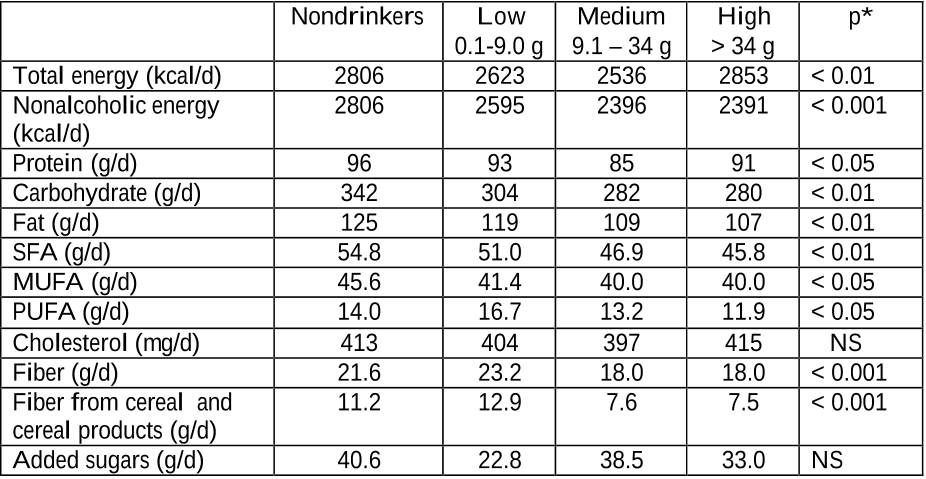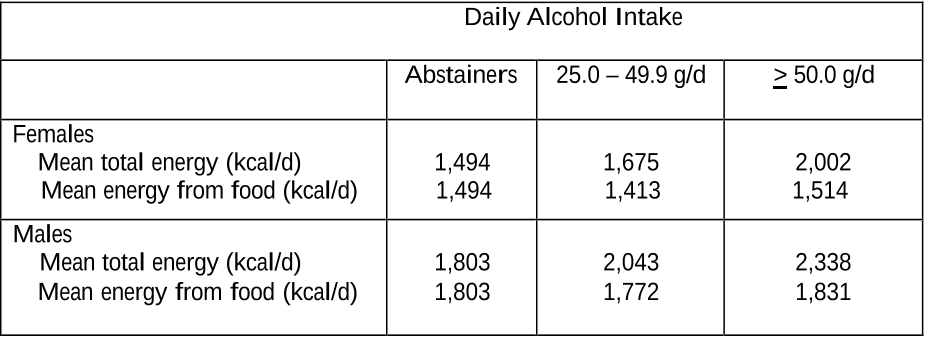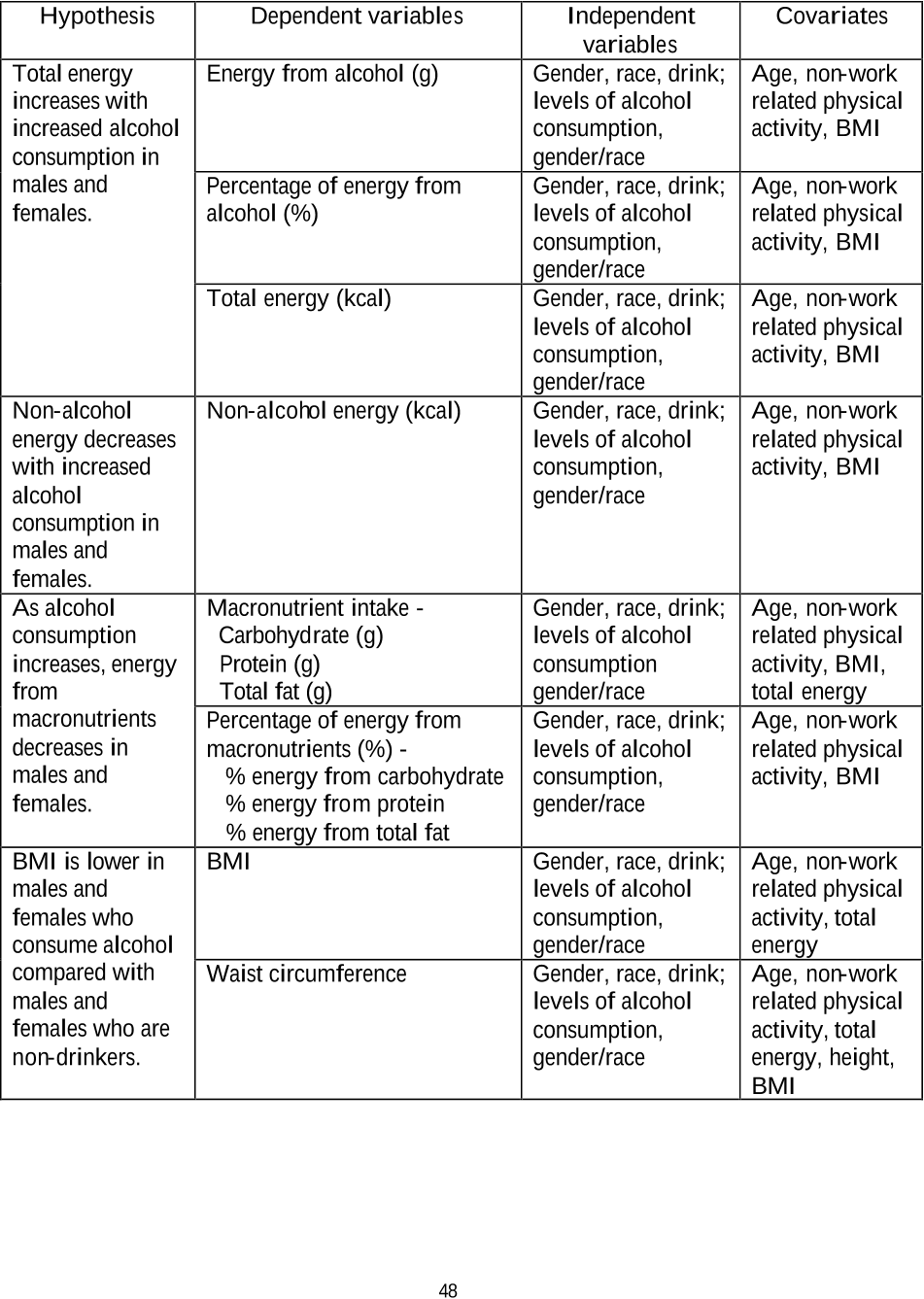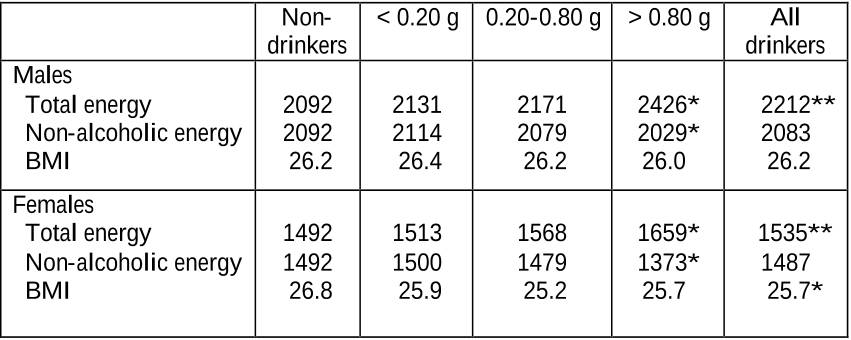The Relationship Among Alcohol Consumption, Dietary Intake, and Body Mass Index in Young Adults
About: This article is published in Journal of The American Dietetic Association.The article was published on 2005-08-01 and is currently open access. It has received 2 citations till now. The article focuses on the topics: Body mass index.
Summary (1 min read)
Jump to: [Introduction] – [Prevalence of Alcohol Consumption in Young Adults] – [Alcohol Metabolism] – [Overview] and [Body Mass Index]
Introduction
- She is an excellent mentor for whom my respect has grown tremendously over the past semesters.
- In 1995 to 1996, the Bogalusa Heart Study (BHS), an epidemiologic study of CVD risk factors from birth through young adulthood, surveyed young adults who were BHS participants in childhood to assess dietary intake and alcohol consumption.
- The YAQ is a semi-quantitative food frequency questionnaire in which foods are grouped into broad categories.
Prevalence of Alcohol Consumption in Young Adults
- The National Household Survey on Drug Abuse , a project of the Substance Abuse and Mental Health Services Administration of the federal government, was initiated in 1971 and is the primary source of information on the use of illicit drugs, alcohol, and tobacco (13).
- NHANES reports that the prevalence of overweight and obesity for adults was relatively constant from 1960 to 1980; however, by 1988-1994 NHANES III, overweight 12 and obesity increased significantly for white and black males and females aged 20 to 74 (45).
- They were shown to be valid and reproducible in both populations.
- Energy from alcohol was added to the diets of light drinkers but replaced non- alcohol energy, especially from carbohydrates, in moderate and heavy drinkers (15).
- A study of 179 middle-class males was designed to quantify long-term alcohol intake and to investigate the relation of level of alcohol consumption with dietary intake (71).
Alcohol Metabolism
- The paradoxical inverse relation sometimes seen between alcohol consumption and body weight remains unexplained by nutritionists.
- When alcohol energy was added to non-alcohol energy, subjects failed to gain weight (78, 81).
- Alcohol may increase meal size through a combination of direct and indirect effects (95).
- Frequency of drinking was consistently lower for females than for males.
- Possible effects of changes in marital status, employment status, and having children on alcohol consumption and the frequency of heavy drink ing was examined in 1,327 males and females aged 16 to 69 years (119).
Overview
- General data collection procedures used in the Bogalusa Heart Study (BHS) are described below; however, a specific data set was used for this thesis.
- The study design, participation, and protocols are described in detail elsewhere (39).
Body Mass Index
- The adjusted means (+ SE) for BMI (kg/m2) of drinkers by gender, race, and race/gender are shown in Table 11a.
- No other significant differences were seen among levels of alcohol consumption.
- Waist Circumference Table 12a shows the adjusted means (+ SE) for waist circumference (cm) of drinkers by gender, race, and race/gender.
Did you find this useful? Give us your feedback
Figures (13)

Table 2 Mean daily intake of energy (kcal/d) and selected dietary components (g/d, mg/d) according to level of alcohol consumption for 164 males (70) 
Table 7c Frequencies and percentages of non-drinkers and drinkers by race and gender 
Table 8b Adjusted means (+ SE) for alcohol intake (g/d) and the 
Table 1 Adjusted mean energy intake (kcal/d) by level of alcohol intake, in females and males (66) 
Table 10c shows the adjusted means (+ SE) for non alcohol energy intake (kcal/d) 
Table 5 Relation of health-related behaviors at three levels of alcohol intake (71) 
Table 6 Hypothesis, dependent variables, independent variables, and covariates used in the univariate ANOVA 
Table 11b Adjusted means (+ SE) for BMI (kg/m2) for non-drinkers and drinkers 
Table 14a Adjusted means (+ SE) for protein (g) and percentages (%) of total energy from protein for drinkers by gender, race, and race/gender 
Table 4 Mean total energy intake and energy sources at three levels of alcohol consumption (71) 
Table 3 Age-standardized daily energy intakes and BMIs for males and females by alcohol consumption (15) 
Table 15a Adjusted means (+ SE) for total fat (g) and percentages (%) of 
Figure 1. Past alcohol use by age: 2001 (Source: NHSDA).
Citations
More filters
01 Jan 1983
TL;DR: Intake of spirits and beer as well as smoking was measured by questionnaire in a random population sample from two counties of Eastern Finland in 1972 and during a 7-yr follow-up 209 of these men had developed an acute myocardial infarction and 223 men had died.
Abstract: Intake of spirits and beer as well as smoking was measured by questionnaire in a random population sample from two counties of Eastern Finland in 1972. At the same time serum cholesterol, triglycerides and blood pressure were measured in a field examination. The study material consists of 4063 men aged 30-59 years (participation rate 92%). During a 7-yr follow-up 209 of these men had developed an acute myocardial infarction (AMI) and 223 men had died. Reported spirits and beer intake had both a strong positive association with smoking and serum triglycerides, a weak positive association with diastolic blood pressure, but no relationship to serum total cholesterol. Use of spirits at least once a week was associated with a reduced risk of AMI. The relative risk (RR), adjusted for age and conventional coronary risk factors was 0.5 (95% confidence interval (CI), 0.3-0.9). Consumption of beer had no significant relationship to the risk of AMI. Consumption of at least five bottles of beer a week was related to a slightly excessive risk of death from any cause (adjusted RR = 1.5, 95% CI = 1.0-2.1). Spirits intake had no significant association with the risk of death.
84 citations
01 Jan 1987
TL;DR: For example, this article found that women who consumed alcohol 7-13 times per week had the greatest reduction in weight, while men had only a slight effect on weight in either survey.
Abstract: Alcohol contributes more than 10 per cent of the total caloric intake of adult drinkers in the United States. However, the effect of alcohol on body weight has not been adequately studied in the general population. The association between weight and frequency of alcohol consumption was examined in two national cross-sectional surveys: the Second National Health and Nutrition Examination Survey (HANESII; n = 10,929) and the Behavioral Risk Factor Surveys (BRFS; n = 18,388). Linear multiple regression was used to estimate the independent effect of alcohol on weight, adjusting for smoking, age, diet practices, physical activity, race, education, and height. Among men, alcohol had only a slight effect on weight in either survey. However, among women, alcohol was associated with a substantial reduction in weight, which was as large as the effect of smoking. Compared with nondrinkers, women who consumed alcohol 7-13 times per week had the greatest reduction in weight: -3.6 kg (95% confidence limits [CL] = -5.6,...
6 citations
References
More filters
TL;DR: Overall results indicated that both cross-sectionally and prospectively, the determinants of weight and weight change are multifactorial.
Abstract: OBJECTIVES: This study examined cross-sectional and prospective relationships between macronutrient intake, behaviors intended to limit fat intake, physical activity and body weight. DESIGN: The overall goal was to identify diet and exercise behaviors that predict and/or accompany weight gain or loss over time. Specific questions addressed included: (a) are habitual levels of diet or exercise predictive of weight change; (b) are habitual diet and exercise levels associated cross-sectionally with body weight; and (c) are changes in diet and exercise associated with changes in body weight over time? PARTICIPANTS: Subjects were a sample of community volunteers (n=826 women, n=218 men) taking part in a weight gain prevention project over a 3-year period. MEASURES: Body weight was measured at baseline and annually over the study period. Self-report measures of diet and exercise behavior were also measured annually. RESULTS: Among both men and women, the most consistent results were the positive association between dietary fat intake and weight gain and an inverse association between frequency of physical activity and weight gain. Individuals who weighed more both ate more and exercised less than those who weighed less. Individuals who increased their physical activity level and decreased their food intake over time were protected from weight gain compared to those who did not. Frequency of high-intensity physical activity was particularly important for both men and women. Additionally, women who consistently engaged in higher levels of moderate physical activity gained weight at a slower rate compared to women who were less active. CONCLUSIONS: Overall results indicated that both cross-sectionally and prospectively, the determinants of weight and weight change are multifactorial. Attention to exercise, fat intake and total energy intake all appear important for successful long term control of body weight.
247 citations
TL;DR: The proportion of men who can be considered as "binge drinkers" was relatively high, and the absence of sizable socio-economic differences suggest that drinking may be spread relatively uniformly in Russia, especially among males.
Abstract: Aims. Alcohol has been suggested as an important determinant of mortality in Russia but survey data on individuals' alcohol consumption in Russia are sparse. We have analysed the levels and distribution of alcohol consumption in a national sample of the Russian population. Design. Cross-sectional survey. Participants. A multi-stage random sample of men and women of the Russian Federation (N = 1599, response rate 66%). Measurements. Data on frequency of drinking alcohol and the average amount consumed at one occasion were collected in an interview. Information was also collected on smoking, self-rated health and a broad range of socio-economic factors and political attitudes. Findings. Nine per cent of men and 35% of women reported that they never drink alcohol; 10% of men and 2% women drink several times a week; 44% of men and 6% of women reported that they drink an equivalent of 25 cl of vodka or more at one occasion and 31% of men and 3% of women would do so at least once a month (25 cl of vodka contains 78.5 g of absolute alcohol). There were differences in alcohol consumption between geographical areas. Material deprivation was not related to alcohol consumption. Among men, smokers, unmarried, unemployed and men reporting poor health consumed more alcohol; women with higher education, widows, non-smoking and with worse health consumed less alcohol. Variables related to reaction to economic and political changes, rating of family economic situation general satisfaction or political preferences were not related to alcohol consumption. Conclusions. While the overall levels of alcohol consumption appeared low, possibly due to under-reporting, the proportion of men who can be considered as "binge drinkers" was relatively high. The absence of sizable socio-economic differences suggest that drinking may be spread relatively uniformly in Russia, especially among males. Alcohol consumption seems unrelated to individuals' perception of the recent societal changes.
238 citations
TL;DR: The finding that the dimensions of drinking operate differently explains the lack of consistency in previous research, which has investigated socioeconomic status and the volumes of alcohol consumed.
Abstract: Aims To investigate the relationship between several indicators ofsocioeconomic status and drinking patterns in young adulthood.
Design Data collected in a longitudinal study of young adults was analysed usingrepeated-measures models to examine the relationship between income, occupationalactivity and educational achievement and patterns of drinking.
Setting These data were collected as part of a longitudinal study ofa birth cohort of New Zealanders. They were interviewed for themost part in a central location using a face-to-face methodand a computer-assisted alcohol interview.
Participants The participants were members of the Dunedin Multidisciplinary Healthand Development study aged 18, 21 and 26 years. Nine hundred andsixty-nine study members contributed to the analysis. Study membershave been found to be broadly representative of the New Zealandpopulation and cross national studies suggest findings are generalizableto other similar market economies.
Measurements Three indicators of socioeconomic status were used; educationalachievement, occupational activity and income. The educational achievementindicator at age 18 had three levels that ranged from no school qualificationsto higher school qualifications. For age 21 two additional categoriesof tertiary educational achievement were included to make five categories andfor age 26 higher tertiary degrees were included in the measureto make six categories. Five categories of occupational activitywere used. Income data was also used. Two measures of alcohol consumptionwere used. These were the frequency of drinking and the typicalquantity of alcohol consumed per drinking occasion in the past year.
Findings Frequency of drinking increased over these early adult yearsand the quantities consumed peaked at age 21 and decreased thereafterfor both males and females. Frequency of drinking was influencedby income with the higher income respondents drinking more oftenand this was persistent overtime. Quantity of drinking was mostinfluenced by educational achievement. The less well-educated youngadult drank significantly more during a drinking occasion and atall ages. There was also a relationship between educational achievement andfrequency of drinking for males at age 18 and a relationship between women’soccupational activity and the quantities they consumed.
Conclusions The finding that the dimensions of drinking operate differently explainsthe lack of consistency in previous research, which has investigated socioeconomicstatus and the volumes of alcohol consumed. The findings of higherquantities consumed among those of lower social status may explain someof the reduced life expectancy found among those with lower socioeconomicstatus.
235 citations
TL;DR: The most salient difference in nutrient intake between drinkers and nondrinkers was the substantially lower carbohydrate intake of drinkers, suggesting that alcoholic calories may be less efficiently utilized than non alcoholic calories, or may interfere with utilization of nonalcoholic calories.
219 citations
TL;DR: Ethanol, either added to the diet or substituted for other foods, increases 24-hour energy expenditure and decreases lipid oxidation.
Abstract: Background. Ethanol can account for up to 10 percent of the energy intake of persons who consume moderate amounts of ethanol. Its effect on energy metabolism, however, is not known. Methods. We studied the effect of ethanol on 24-hour substrate-oxidation rates in eight normal men during two 48-hour sessions in an idirect-calorimetry chamber. In each session, the first 24 hours served as the control period. On the second day of one session, an additional 25 percent of the total energy requirement was added as ethanol (mean [±SD], 96±4 g per day); during the other session, 25 percent of the total energy requirement was replaced by ethanol, which was isocalorically substituted for lipids and carbohydrates. Results. Both the addition of ethanol and the isocaloric substitution of ethanol for other foods reduced 24-hour lipid oxidation. The respective mean (±SE) decreases were 49.4±6.7 and 44.1 ±9.3 g per day (i.e., reductions of 36±3 percent and 31 ±7 percent from the oxidation rate during the control...
211 citations